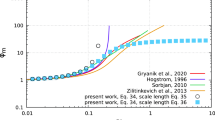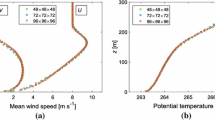Abstract
A turbulent energy model is developed to simulate the response of a neutrally stratified atmospheric boundary layer to sudden changes in surface roughness. A mechanism of turbulent energy transfer is proposed, based upon the results of numerical experiments, that explains the distribution of shear stress and hence the distribution of velocity profiles in the atmospheric surface layer. Two length scales associated with the turbulent energy equation are obtained from experimental data and the law of the wall. Turbulent energy is also predicted.
The predicted growth of the internal boundary layer is slower than that obtained from mixing-length models. Also, the predicted surface shear stress obtained from the turbulent energy model is in better agreement with field data than that obtained from mixing-length models.
Similar content being viewed by others
References
Bradley E. F.: 1968, ‘A Micrometeorological Study of Velocity Profiles and Surface Drag in the Region Modified by a Change in Surface Roughness’, Quart. J. Roy. Meteorol. Soc. 94, 361–379.
Bradshaw, P., Ferriss, D. H., and Atwell, N. P.: 1967, ‘Calculation of Boundary-Layer Development Using the Turbulent Energy Equation’, J. Fluid Mech. 28, 593–616.
Cramer, H. E. and Record, F. A.: 1969, Properties of Turbulent Energy Spectra and Cospectra in the Atmospheric Surface Layer, U.S. Army Electronic Command, Atmospheric Technical Report ECOM-64-G1-F, Fort Huachuca, Arizona, 95 pp.
Dryden, H. L.: 1946, Paper presented at 6th Inter. Congr. Appl. Mech. (see also Nat. Adv. Comm. Aero. Wash. Tec. No. 1168 (1947)).
Elliott, W. P.: 1958, ‘The Growth of the Atmospheric Internal Boundary-Layer’, Trans. Amer. Geophys. Union 39, 1048–1054.
Hinze, J. O.: 1959, Turbulence, McGraw Hill, New York, 586 pp.
Huang, C. H. and Nickerson, E. C.: 1974, ‘Stratified Flow over Non-Uniform Surface Conditions: Mixing Length Model, Boundary-Layer Meteorol. 5, 395–417.
Mellor, G. L. and Herring, H. J.: 1968, ‘Two Methods of Calculating Turbulent Boundary Layer Behavior Based on Numerical Solutions of the Equations of Motion. I: Mean Velocity Field Method; II: Mean Turbulent Field Method’, Proceedings-Computation of Turbulent Boundary Layers, 1, AFORS-IFP-Stanford Conference, Stanford University, Mechanical Engineering Dept.
Nickerson, E. C.: 1968, ‘Boundary Layer Adjustment as an Initial Value Problem’, J. Atmospheric Sci. 25, 207–213.
Onishi, G. and Estoque, A.: 1968, ‘Numerical Study on Atmospheric Boundary Layer Flow over Inhomogeneous Terrain, J. Meteorol. Soc. Japan 46, 280–286.
Panofsky, H. A. and Townsend, A. A.: 1964, ‘Change of Terrain Roughness and the Wind Profile’, Quart. J. Roy. Meteorol. Soc. 90, 147–155.
Petersen, E. L. and Taylor, P. A.: 1973, ‘Some Comparisons between Observed Wind Profiles at Risö and Theoretical Prediction for Flow over Inhomogeneous Terrain’, Quart. J. Roy. Meteorol. Soc. 99, 329–336.
Peterson, E. W.: 1969, ‘Modification of Mean Flow and Turbulent Energy by a Change in Surface Roughness under Conditions of Neutral Stability’, Quart. J. Roy. Meteorol. Soc. 90, 561–576.
Prandtl, L.: 1945, ‘über ein neues Formelsystem für die ausgebildete Turbulenz’, Nachrichten der Akad. Wiss. Göttingen Mathphys. K1, 6–19.
Rotta, J. C.: 1951, ‘Stratische Theorie nichthomogener Turbulenz’, Z. Phys. 129, 547–572, and 131, 51–77.
Rotta, J. C.: 1962, ‘Turbulence Boundary Layers in Incompressible Flow’, Progress in Aeronautical Sciences 2, Pergamon Press.
Taylor, P. A.: 1969, ‘On Wind and Shear Stress Profiles Above a Change in Surface Roughness’, Quart. J. Roy. Meteorol. Soc. 95, 77–91.
Taylor, P. A.: 1973, ‘Some Comparisons Between Mixing-Length and Turbulent Energy Equation Models of Flow Above a Change in Surface Roughness’, Proc. 3rd Int. Conf. on Numerical Models in Fluid Dynamics, Univ. of Paris VI, July 3–7, 1972, Springer-Verlag, Vol. II, 246–253.
Uzkan, T. and Reynolds, W. C.: 1967, ‘A Shear-Free Turbulent Boundary Layer’, J. Fluid Mech. 28, 803–821.
Yeh, F. F. and Nickerson, E. C.: 1970, Airflow over Roughness Discontinuity, Technical Rept. No. 8. Project Themis. Fluid Dynamics and Diffusion Laboratory, College of Engineering, Colorado State Univ., Ft. Collins, Colo.
Author information
Authors and Affiliations
Rights and permissions
About this article
Cite this article
Huang, CH., Nickerson, E.C. Stratified flow over non-uniform surfaces: Turbulent energy model. Boundary-Layer Meteorol 7, 107–123 (1974). https://doi.org/10.1007/BF00224975
Revised:
Issue Date:
DOI: https://doi.org/10.1007/BF00224975




